
Vault_2-_Cases
.pdf
Vault Case Interview Practice Guide 2: More Case Interviews
Sample Cases
ceptionally sure of the idea you have brought up, a neutral to negative response should suggest the interviewer wants you to consider a different approach.)
Firm: That’s an interesting suggestion. It is quite possible that the market is still receptive to lower cost pieces of a system rather than a full-blown network and you are correct, it would potentially broaden your customer base as well. How would you explore this further?
(Any business decision hinges in large part on quantifying the costs and benefits involved and it is important to investigate them as part of any recommendation. Your interviewer may or may not require it, but you need to show that you can handle the numbers involved if required.)
Interviewee: It would be important to quantify this as a potential opportunity so that any decisions made are not just based on gut feeling. My next step in exploring this would be to match pieces of software that can be sold independently to companies that are potential customers. This will help develop some sort of market sizing estimate. Do we have any information relevant to this?
Firm: The client has not worked through any numbers as yet, since it does not know whether any such breakdown of its software is even possible. At this early stage it is just trying to get a high-level understanding of what the end-to- end process might look like. Assuming there is a big enough market to make this worthwhile, what would you advise them to do next?
(Do a mental recap of the analysis structure you proposed to see where you are. The interviewer has more than likely kept the structure you proposed in the back of his or her mind and will want to see that you are using it—if you need to drastically deviate from it, that’s OK, but let the interviewer know you are doing this and why.
Interviewee: So far we have determined there is a product the company can put together and despite the overall industry going through a lean phase there is a market for this product due to its lower cost. I would next like to understand details of the market to assess what the client needs to do to bring such an offering to the market, and if the client has the necessary resources to do so. I would like to initially look at competitor offerings, pricing strategies and channels to place the product, but may need to look at other things as well as we move ahead.
(It’s good to leave the door open for anything that you may think of later.)
Firm: Let’s ignore pricing and competitors for now and focus on channels for introducing the product to market. What channels would you suggest the client explore for launching such a product?
152 |
C A R E E R |
© 2008 Vault.com Inc. |
L I B R A R Y |
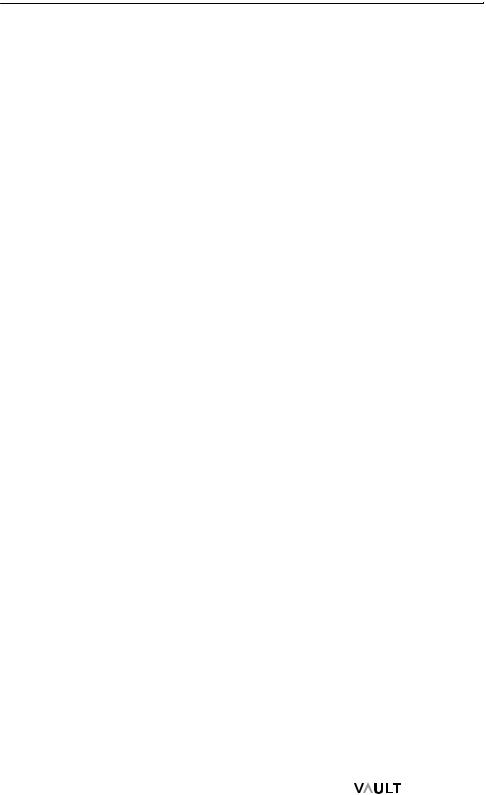
Vault Case Interview Practice Guide 2: More Case Interviews
Sample Cases
(Here is another opportunity to show some creativity. Remember though that the client will be launching to a narrow range of customers. One way to think about it in a structured manner is to keep different kinds of media types (print, audio-visual, electronic, etc.) in mind. Think about which ones might be appropriate and have suitable examples for each of them.)
Interviewee: Given that the client is targeting a very specific customer base, I would hypothesize they do not need a mass campaign. Rather they should focus on channels that are narrow but relevant for companies in this specific industry. Such channels could include trade magazines and journals in the print media; industry trade fairs where the client’s representatives can speak to several companies as well as direct mailers and a road show to the major firms for more one-on-one interaction and sales pitches.
Firm: I think that’s reasonable. Thank you.
Case analysis
This case requires you to go through the steps of thinking about the possibility of repackaging an existing product and launching it afresh in the market. You develop the case by moving through decisions on several smaller components. For example you have to decide if there is any product to support the new business model under consideration, if there is a reasonable market for it, what channels could be used to bring the product to market and so on. The analysis would be incomplete if you did not consider these components individually and use decisions about each of them as building blocks for the overall issue. This highlights the need for a good initial structure to be sure you cover most if not all the important areas that could influence such a decision.
The case could have become far more quantitative at several points. For example, when proposing to break up the product offering into smaller pieces and offer it to the market at lower cost, the interviewer could have chosen to make this into a market sizing-related case, where you might need to calculate such things as revenue potential. Do not become nervous or concerned about your unfamiliarity with the industry, as interviewers will not expect you to have specific knowledge about it. What they will expect is for you to be able to abstract out of the situation the business decisions and structured thinking that need to be applied, and then hone in to use case and industry specific facts (which are uncovered during the course of the interview) to refine your analysis and recommendations.
Visit the Vault Consulting Career Channel at www.vault.com/consulting — with insider firm profiles, message boards, the Vault Consulting Job Board and more.
L I B R A R Y |
153 |
C A R E E R |
|

Vault Case Interview Practice Guide 2: More Case Interviews
Sample Cases
Specialty Kitchenware Brand Case
A private equity firm client is considering buying the U.S. distribution rights to a brand of European specialty kitchenware. The asking price for the distribution rights is $10 million. The kitchenware brand up for sale is not currently sold in the U.S. The client has hired our firm to advise on whether or not this is a good idea. How would you structure our response?
Additional information provided during questioning
•The client is a typical private equity (PE) firm. It usually makes investments for no more than five years. It is a N.Y.-based firm. The client typically makes investments of no more than $10 million dollars. The client does not have any other holdings in the kitchenware mark—this is a new market for it, and that’s one of the reasons why it has hired us.
•In order for the PE client to purchase the rights, it needs to be able to grow revenue for the brand to $50 million in five years.
•Not much is known about the specialty kitchenware market in the U.S. There are no analyst reports on the market, its trends or growth rates. The brand up for sale consists of cookware, ceramics, pots, pans and specialty utensils priced at $40 to $500 apiece.
Suggested high-level overview of solution
This is a three Cs case—with the “company” and “customer” Cs tailored to this specific case—which is easily analyzed with a quick market-sizing exercise. Numbers really drive the answer, and the interviewee needs to remember that this is a PE firm—if the numbers are not achievable quickly, it’s not a good buy for the firm.
There is one “brainstorming” exercise, in which an interviewee can demonstrate his or her creativity in finding data, which is always a helpful skill for a consultant.
Breakdown of solution (including quantitative analyses and qualitative evaluations)
Interviewee: So, let me just make sure that I understand the case: The client is a private equity firm, and it has hired us to help it decide whether to buy the
154 |
C A R E E R |
© 2008 Vault.com Inc. |
L I B R A R Y |
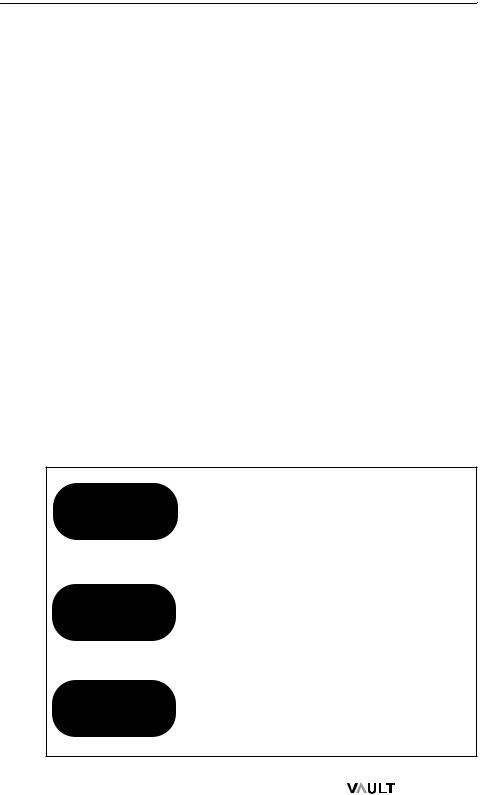
Vault Case Interview Practice Guide 2: More Case Interviews
Sample Cases
U.S. distribution rights to a specialty kitchenware line. The asking price is $10 million. Is that correct?
Firm: Yes. That’s right.
Interviewee: Before I collect my thoughts, does the PE firm specialize in bringing European brands to the U.S., or in kitchenware?
Firm: Those are good questions. The answer is that it does not. The client is a typical private equity firm. It usually makes investments for no more than five years. It is a N.Y.-based firm. The client typically makes investments of no more than $10 million dollars. The client firm does not have any other holdings in the kitchenware market—this is a new market for it, and that’s one of the reasons why it hired us.
Interviewee: Great. Do you mind if I take a few minutes to collect my thoughts?
Firm: Not at all. Take your time.
(Few minutes go by …)
Interviewee: I have three main topics that I’d like to analyze to make a decision on buying these rights: 1) the product line/brand, 2) consumers/retailers in the specialty kitchenware, and overall kitchenware market in the U.S., and 3) the competition in the kitchenware market. I divided the key questions for my analysis in those as follows:
BRAND/PRODUCT
LINE
CONSUMERS/ RETAILERS
COMPETITION
•What is the product offering that we’re buying? What’s its price range? How differentiated would it be in the market?
•What’s the brand awareness in the U.S. right now?
•How many consumers are there for this sort of product? Is the consumer base growing in the U.S.?
•How much are consumers willing to pay for this product?
•How many retailers are there for this product line? How much do they need it?
•How much competition is there in the market?
•Is the competition likely to increase or decrease in the near future?
Visit the Vault Consulting Career Channel at www.vault.com/consulting — with insider firm profiles, message boards, the Vault Consulting Job Board and more.
L I B R A R Y |
155 |
C A R E E R |
|

Vault Case Interview Practice Guide 2: More Case Interviews
Sample Cases
Firm: That’s a great way to start. In terms of your questions about the market, I have some not-so-great news: Not much is known about the specialty kitchenware market in the U.S. There are no analyst reports on the market, its trends or growth rates. The brand up for sale consists of cookware, ceramics, pots, pans and specialty utensils priced at $40 to $500 apiece—quite expensive. But the margins are great on the product; so, that’s why the client is interested in it.
Interviewee: That answers a lot of my questions about the brand/product line. Do we know much about consumers or the competition in the market?
Firm: Not really—that’s a big part of why the client hired us. And that brings me to my next question: What kind of research would you do to find out about the market and to answer some of the key questions that you’ve defined?
(This is the brainstorming exercise. An interviewee should come up with three to four ways/data sources that they might look to find out about the market. A more exhaustive list, included below, is divided up by the key buckets of information that the interviewee already outlined.)
Interviewee: I can think of several data sources that might answer some of my questions. Other than analyst reports, which you’ve already said don’t really exist for this market, I can think of using lit searches on the specialty kitchenware market in the U.S., trade journals on kitchenware, consumer and market data on the brand and product line in Europe from the company that the client is considering buying the rights from, primary research on shelf space devoted to high-end kitchenware in key retailers (like Bed, Bath and Beyond, WilliamsSonoma, Crate & Barrel, etc.), analyst and annual reports on cookware retailers in the U.S., analyst and annual reports on cookware manufacturers in the U.S., and interviews or surveys with cookware consumers in the U.S.
156 |
C A R E E R |
© 2008 Vault.com Inc. |
L I B R A R Y |
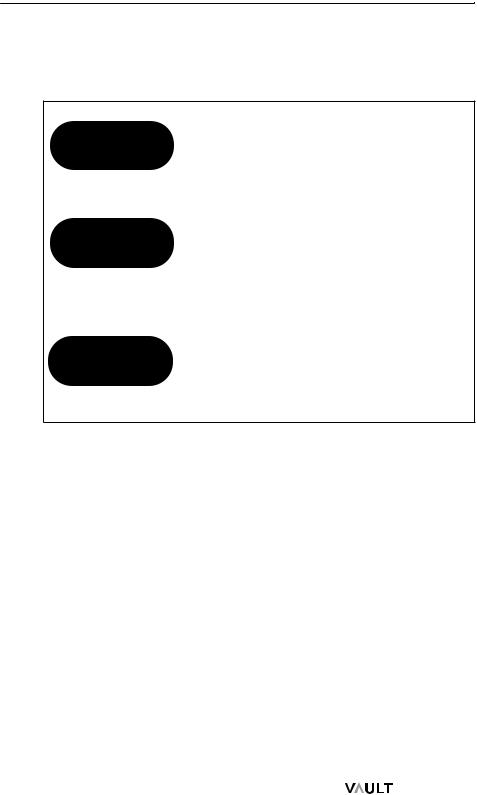
Vault Case Interview Practice Guide 2: More Case Interviews
Sample Cases
(The following is a more detailed and compartmentalized list of the above, but really, a brainstormed list like the one above is fine for an exercise like this in a case interview.)
COMPETITION
CONSUMERS/ RETAILERS
BRAND/PRODUCT
LINE
•Lit search on brand/product line in Europe
•Lit search on cookware brands/products in the U.S.
•Trade journals on cooking, cookware, kitchenware
•Product line/brand info from company in Europe
•Primary research in/visits to cookware retailers (C&B, Williams-Sonoma, BB&B) to measure shelf space allocations
•Consumer data on brand consumers in Europe
•Interviews/surveys with consumers in the U.S.
•Annual reports/analyst reports on cookware retailers in the U.S.
•Lit searches on cookware manufacturers in the U.S.
•Analyst and annual reports on cookware manufacturers in the U.S.
•Trade journals on cookware/kitchenware
•Shelf-space analysis in cookware retailers
Firm: That’s great, and a really good list of potential data sources. Now, in order for the PE client to purchase the rights, it needs to be able to grow revenue for the brand to $50 million in five years. Knowing that, how would you decide if it’s a good idea to buy the rights?
Interviewee: Well, I would need to know the size of the current specialty kitchenware market and estimate how much of that market I think this new brand could get in five years.
Firm: That’s right. What would you size the market at?
(The following market sizing is illustrative but is not the only market sizing that would be reasonable. An interviewee should definitely know the assumptions that the U.S. has a population of 275 to 300 million and that there are approximately 100 million households in the U.S.—those are considered common knowledge for case interviews. Other than that, an interviewee should feel free to make assumptions that are reasonable in order to get to a “back of the envelope” market size. The main piece of advice is that the interviewee should make assumptions, but check in with the interviewer on whether those assumptions are reasonable.)
Visit the Vault Consulting Career Channel at www.vault.com/consulting — with insider firm profiles, message boards, the Vault Consulting Job Board and more.
L I B R A R Y |
157 |
C A R E E R |
|

Vault Case Interview Practice Guide 2: More Case Interviews
Sample Cases
Interviewee: Because kitchenware is purchased on a household basis, I’d like to size the market in terms of households, instead of in terms of individual consumers.
Firm: That seems like a good idea.
Interviewee: I know that the U.S. has approximately 100 million households. Let’s assume that while most all of those households are consumers of the cookware market, most are not consumers of the specialty or high-end kitchenware market. Let’s assume that only about 10 percent of households would be the consumers that we should be interested in. Is that fair?
Firm: Yeah, that’s about right—it’s a little bigger than that, and I think that we’re hoping to grow the market, why don’t we use 20 percent?
Interviewee: Great—20 percent then; so, there are about 20 million households that we’re concerned with. Now, I’m going to assume that since specialty kitchenware is probably a fairly durable good …
Firm: Yes, it is—for the prices that these spatulas sell for!
Interviewee: Yes, so, I’m going to assume that those 20 million households probably only make a specialty cookware purchase once every five years. So, in any given year, only about four million households are purchasing.
Firm: That’s a good assumption.
Interviewee: Now, if I remember correctly, you said that the products in the line ranged from $40 to $500/product—can I assume that that’s similar to the rest of the specialty cookware market?
Firm: Sure.
Interviewee: The middle of that range is $270, and I’m going to assume that a household purchasing each year buys only one product, just to be a bit conservative in my market sizing. So, that’s $270 spent each year by four million households. If you multiply those out, you get a total specialty cookware market size of $1.08 billion.
Firm: That seems reasonable—maybe a bit high, but our client is hoping to grow the market as well as its share if it makes this investment. Now, getting back to the question of the case: Should the client buy the rights?
Interviewee: Well, if I remember correctly, you said that the client would only consider buying the rights if it could achieve a revenue of $50 million in the first five years. That’s only a 5 percent market share in five years, which seems
158 |
C A R E E R |
© 2008 Vault.com Inc. |
L I B R A R Y |
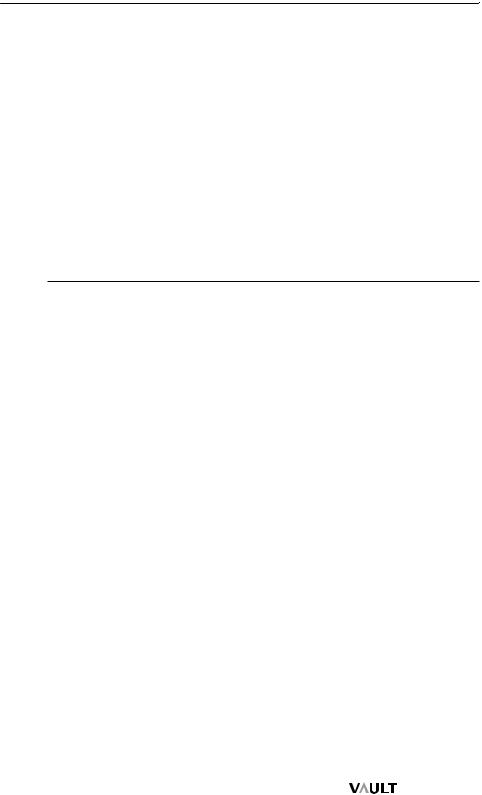
Vault Case Interview Practice Guide 2: More Case Interviews
Sample Cases
doable but aggressive. Does the PE client have any expertise in marketing new brands?
Firm: Actually, it does. The PE firm has a really great marketing company that it works with and believes that it could get 5 percent of the specialty kitchenware market in the U.S. within five years.
Interviewee: Well, if that’s the case, then even if my market sizing is off, the client’s goals do seem achievable and it should purchase the rights to the brand in the U.S.
Firm: That’s great. We’re done.
Telecom Equipment/Services Provider Case
A large telecom equipment provider has seen its profitability decline in recent years. It has hired us to find out why and help it turn around its profitability. How would you structure our response?
Additional information provided during questioning
•The client is a global telecom equipment/services provider. It is based in the U.S., but it serves a global customer group.
•The client serves primarily business customers, like large global corporations that need their own global networks, dedicated lines, etc. However, it has started to serve home offices for global business customers and developed small office/home office product lines and operations in markets where those are quite prevalent.
•The global telecom industry surged in the 1990s, but in recent years, due to a tremendous supply in global telecom capacity, demand for telecom equipment dropped quickly. All traditional global telecom manufacturers and suppliers were hit hard by this turn in the market.
•The client has traditionally gotten 80 percent of its revenue from itstelecom equipment manufacturing business and 20 percent from its installation/maintenance and services business.
Visit the Vault Consulting Career Channel at www.vault.com/consulting — with insider firm profiles, message boards, the Vault Consulting Job Board and more.
L I B R A R Y |
159 |
C A R E E R |
|

Vault Case Interview Practice Guide 2: More Case Interviews
Sample Cases
Suggested high-level overview of solution
While this is a profitability case, and the interviewee should layout the structure in terms of the two levers of profitability, an industry analysis using Porter’s Five Forces or the three Cs is really the only way to drive to the actual answer to the case. Both frameworks are laid out, though using the three Cs is probably the simplest. Hypothesis generation and testing is one of the other tools used in this case. Consultants frequently use this with clients; so, the interviewer brings it up here to see how adept the interviewee is at applying it in this situation.
This is not a quantitative case. There’s also not a lot of information in this case. The interviewee really has to use his or her imagination to keep generating ideas—no matter how frustrating that gets—in order to get to an answer. Using several frameworks to structure the problem and generate ideas is really the way to get at the answer.
Breakdown of solution (including quantitative analyses and qualitative evaluations)
Interviewee: Let me just make sure that I understand the case setup correctly. Our client is a large telecom equipment manufacturer and provider that has seen its profitability decline in recent years, and it has hired us to help them figure out how to turn that around?
Firm: Yes. That’s right. How would you approach that problem? Take a few minutes if you need them.
(Few minutes go by …)
Interviewee: Well, this seems like a standard profitability case to me. The two levers of profitability are revenue and costs. Within revenue, you want to look at whether the price of our offering has changed, or whether the volume of how much we sell has changed. Within costs, you can look at whether the fixed costs of the company have changed, or whether the variable costs have changed. Or, we could run down the items of the income statement to see if there are any major changes there.
160 |
C A R E E R |
© 2008 Vault.com Inc. |
L I B R A R Y |
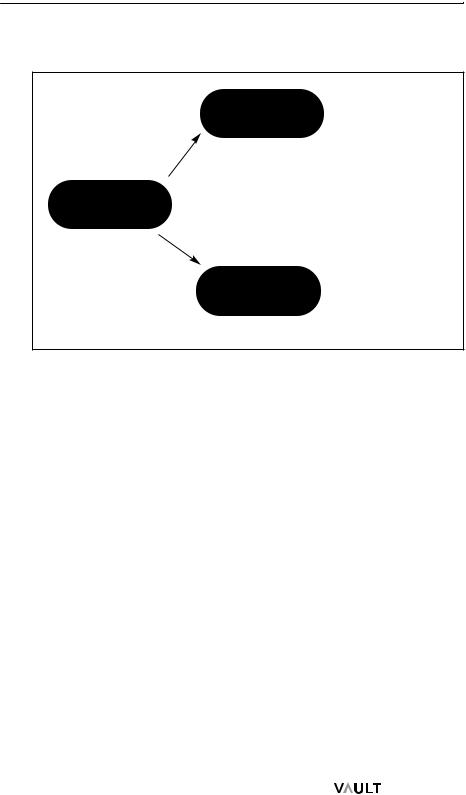
Vault Case Interview Practice Guide 2: More Case Interviews
Sample Cases
(Below is the way to lay out this structure.)
REVENUE |
• Price |
|
• Volume |
||
|
PROFITABILITY
• Fixed costs
COSTS • Variable costs
• Items on income statement
Firm: That’s right. Now, I can tell you from the client’s own knowledge that nothing has changed on the costs side. So, the changes have definitely happened on the revenue side. Where does that take your thinking?
Interviewee: Well, then either the volume has decreased or the price has decreased. I imagine that the client would know if price had decreased; so, I’ll assume that volume has decreased.
Firm: That’s right. So, how would you evaluate looking into why volume has declined for the client?
Interviewee: Can I have a few minutes to collect my thoughts?
Firm: Of course. Just let me know when you’re ready.
(Few minutes go by …)
Interviewee: Well, you would need to do some sort of industry analysis to understand why the client’s volume is declining. I tend to approach these things by dividing my analysis into four main buckets: 1) company/product changes, 2) customer satisfaction, 3) competitive landscape, and 4) overall market dynamics/setting.
Visit the Vault Consulting Career Channel at www.vault.com/consulting — with insider firm profiles, message boards, the Vault Consulting Job Board and more.
L I B R A R Y |
161 |
C A R E E R |
|
